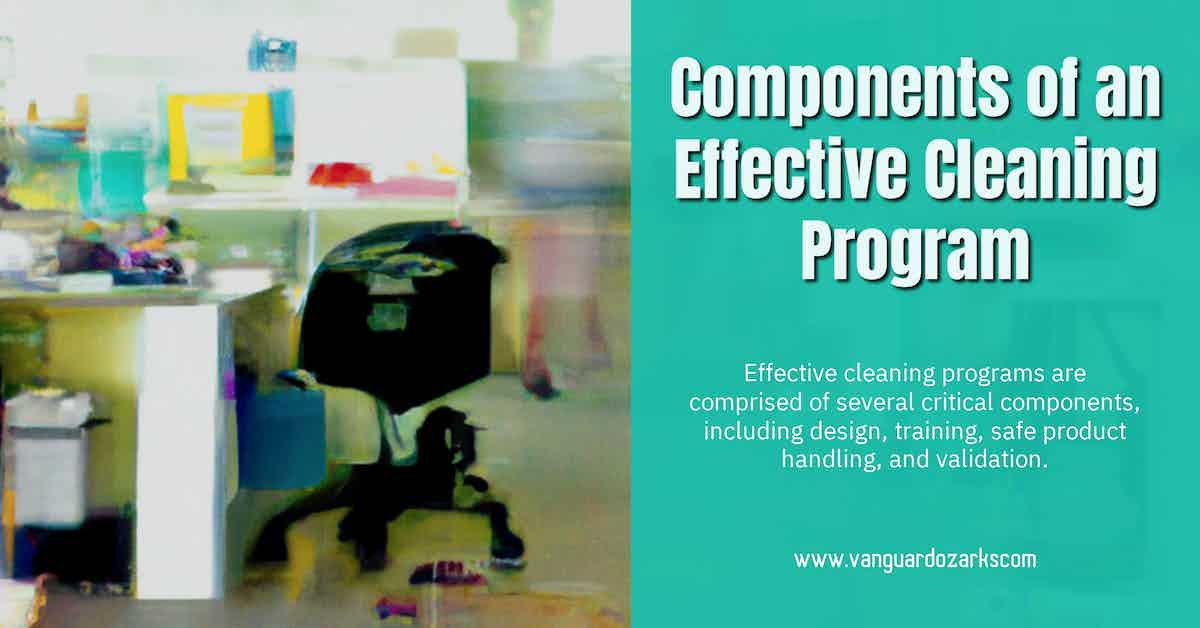Effective cleaning programs are comprised of several critical components, including design, training, safe product handling, and validation.

Defining Effective Cleaning Programs
According to the U.S. Centers for Disease Control and Prevention, " [sic] regardless of type of facility, the key program elements for effective environmental cleaning programs include:"
- Organization/Administration - Corporate leadership and budgeting.
- Staffing and Training - The cleaning teams and how they are prepared to perform their duties.
- Infrastructure and Supplies - Cleaning tools, products, protective equipment, and support services.
- Policies and Procedures - How to clean what, when, and what to do in special circumstances, such as pandemics, and;
- Monitoring, Feedback, and Audit - Is the cleaning program effective? How do the occupants and service providers feel about the service level and requirements, and how does the current process hold up to routine inspection?
Establishing Optimal Cleaning Schedules
Purposeless cleaning and disinfecting are wasteful and dangerous.
Optimal cleaning frequencies are a prerequisite for a healthy building.
Knowing when to clean what conserves resources, protects occupants, and improves operational outcomes.
According to the CDC, in non-healthcare settings, under normal (non-outbreak) conditions:
- High-touch facility surfaces should be cleaned and disinfected several times per day. The process can be streamlined with a combination cleaner/disinfectant applied with a microfiber towel.
- Other work surfaces in office environments should be cleaned daily and disinfected weekly.
- High-risk areas, such as restrooms, kitchens, and dining areas, should be cleaned and disinfected at least once daily.
Cleaning and disinfection frequencies should be increased during localized outbreaks and monitored for effectiveness, safety, and waste.
Effective monitoring policies should include IAQ and ATP surface testing to verify the current cleaning program is contributing to improved facility health.
Additional feedback from occupants and other facility stakeholders will aid in program refinement.
Choosing the Right Products
Commercial cleaning products should be selected with the following in mind:
- Surface - Is the product safe or recommended for use on the surface it is being used on? A common example of this going wrong is when the incorrect product is used to deep clean or strip a floor.
- Safety - Is the product considered safe for use in the building it is being used in and around the general demographics of the typical occupant? For example, a wipe that is registered as safe for use when disinfecting children's toys in daycare facilities.
- Sustainability - Does the product, manufacturer, packaging, and delivery method align with your organization's sustainability policies and targets? Greenwashing is a significant challenge for the cleaning industry, and consumers demand accountability.
- Registered Claim - Is the product registered with the U.S. Environmental Protection Agency (EPA) as effective against any specific pathogen, bacteria, or other microbes your facility is combatting?
References & Resources
Takeaway
Facility cleaning and disinfection requirements vary from building to building, season to season.
The most effective programs adhere to a holistic or bundle approach to facility health, combined with ongoing expert supervision, program monitoring, and occupant feedback.
According to the American Journal of Infection Control;
Because increasing evidence suggests that the environment plays a role in transmission of [...] infections, more attention is focusing on environmental cleaning and improving its efficacy.
Creating and sustaining a successful cleaning and disinfection program should include several key components using a bundle approach and requires ongoing commitment within the institution.
However, because several studies have reported that cleaning practices are often suboptimal, it is now recognized by the Centers for Disease Control and Prevention and professional societies that there is a need for a system for monitoring adherence to recommended cleaning practices to ensure consistent cleaning and disinfection of surfaces[...].
Several studies have shown that monitoring and providing feedback to the housekeeping staff can show significant improvement in their cleaning practices.
Vanguard Cleaning Systems of the Ozarks' franchise-owned custodial service provider business cleans more than 8M sq. ft. each week, maintaining an industry topping 95+% of its customer base, year-over-year, and boasting more than 60 5-star Google reviews.
Need more capability from your vendor partners? --Let’s talk.
In Oklahoma, dial 918-960-4450
In Arkansas, dial 479-717-2410
In Missouri, dial 417-812-9777

